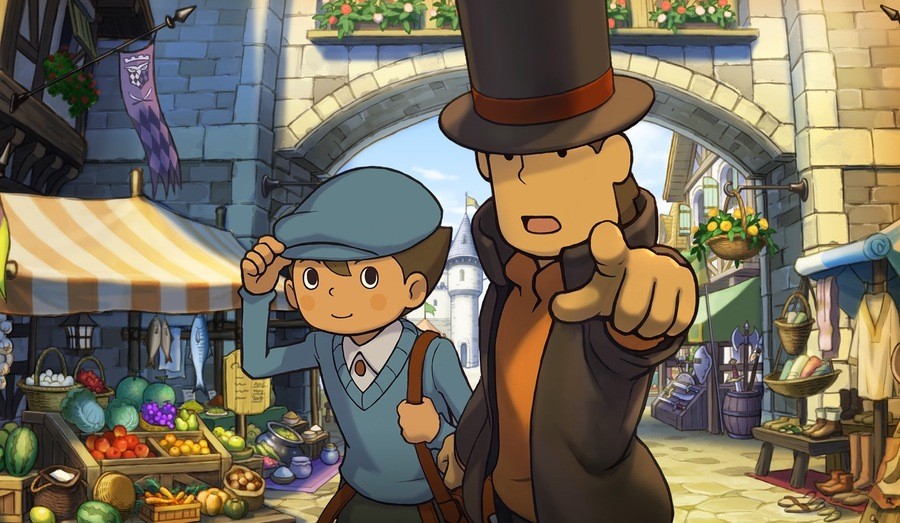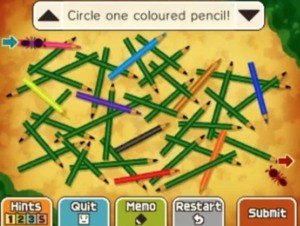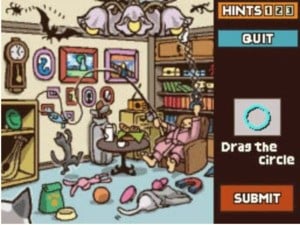
Like many others, the Nintendo DS has a special place in my heart. Preoccupying me for hours over several years, that little plastic plaything accompanied me here, there and everywhere and with it, my strange assortment of games. As a kid, often what was advertised to me were games featuring brands like Pokémon or Mario – titles certainly respectable and family friendly – but one day Professor Layton and the Curious Village caught my eye. My mum also had a DS, and hadn’t taken a fancy to the cartoony style and dark implications contained therein, so, hungry for a new challenge, the young me scrambled to claim the cartridge and loaded it up. It proved to be a fateful moment.
Ever since, the Professor Layton games – just like the DS – have secured a special place in my heart. Although I think they were at their most charming on the DS rather than the 3DS, I don’t think I could recommend a series more highly to all age groups. Although I played the original game long ago, I can still visualise some of the puzzles I particularly enjoyed, or swelled with pride after completing. I couldn’t have been older than 11 when I completed the Curious Village and in coming years I devoured other subsequent titles like Pandora's Box (also known as the Diabolical Box in the USA) and the Lost Future (aka the Unwound Future). And then the 3DS appeared and DS games (and series) shuffled over to their new platform; I shuffled along too, but to a PS4. As such, it’s taken me years to finally play Professor Layton and the Miracle Mask, one of the 3DS continuations of the story, and after playing it, I couldn’t help but notice how brilliant Professor Layton really is.
At the grand old age of 21, I still love Professor Layton, but for a whole host of new reasons, reflected in the gameplay, puzzles, and story. Not knowing how such a story-driven game could appeal so much to me a decade later, I’ve had a good think about my puzzling attitudes, and how I think age will change your evaluation of the situation. To exemplify what I mean, I’ve tried to pick some good examples of puzzles where I think the player’s age is all important.
Professor Layton and the Miracle Mask: A Perilous Adventure, Puzzle 70

This puzzle turned my attention, initially, to the difference between my age and my understanding of games. My tip to anyone playing a Professor Layton game is if you don’t think you can solve the puzzle with the space provided, or your eyes glaze over reading the instructions, put up a red flag. See, as a kid puzzles with win conditions felt like a challenge. An “okay, you’ve come this far, how about this then?” kind of deal.
As an adult, however, I saw the huge amount of text, smirked at the apparent complexity of the puzzle and turned my attention to the true objective. Ant A wants to chill with Ant B. What do you move to achieve that? The answer is Ant A is already on a pencil so just move it, a little like you might in a real-life situation. A very simple solution, veiled with the most complicated explanation possible. A puzzle like that surely would have furrowed my brow for hours a decade ago, but today I sniffed out the solution in under a minute. With age comes wisdom, so they say.
Professor Layton and the Curious Village: The Laziest Man in the World, Puzzle 109

Alright, round two. Now this is a puzzle which might just depend on your thought process, but I can tell you my adult rationalisation actually got in the way of me solving it. This guy (who is living it up, by the way) has designed this room to be incredibly efficient, and in theory at no point will he have to leave his chair to reach anything. The catch is he’s overlooked just one place where, no matter how hard he tries, he can’t get to.
Now, me being a pedant, I looked at the image and thought, “there are several places he can’t reach, like behind the picture frames, or inside the lyre and his claw is pretty impractical”, and yes, that’s all true, but I would be missing the point with my adult brain. The puzzle shouldn’t be over-rationalised with what he’s using, and if in theory you could pick up a book behind your head with a claw, you should take the puzzle at face value. The answer is under his chair. His armchair can’t be reached under because its decor prevents him from getting under it without getting off it and lifting it up. Child's play, then, rather than an adult’s play where one might overindulge in thinking of the puzzle in real-life possibilities.
Professor Layton and Pandora’s Box: A Ticket to Where? Puzzle 59

At several times in my gaming career have I cheated (and by cheated I mean Googled) an answer I couldn’t figure out myself. I’ve found no shame in looking something up when I am completely and utterly lost, and I can remember feeling flummoxed when this vital puzzle was presented years ago. It may just be my nostalgia, but this experience was one which blew my mind and pinned Professor Layton as the perfect puzzle adventure series.
The puzzle goes a little like this. You have a ticket you find in the flat of a dead man. Looking at it in a normal fashion means you can’t see a destination; however, if you look at it in the right way, you’ll find where you need to go. At the end of the description you’re told to look inside your instruction manual to find a clue and there, bold as brass, is a replica ticket. Excited, I went to work orientating the piece of paper in every which-way and direction, being ever so careful not to rip or crease my favourite piece of gaming memorabilia. That, dear reader, was my mistake.
To solve ‘A Ticket To Where?’, you must fold the piece of paper three times. The first halving the ticket horizontally, and then each segment back on itself once again, making three lines across the ticket. When folded in this way, and the top and bottom quarter of the paper is facing you, the numbers that were once there become letters and you get the words “For Folsense”. As an adult, I can say I would have less of a problem solving the puzzle, purely on a lack of sentimentality. I loved that mass-produced piece of paper, for no other reason than it was from a game I adored, and that’s where the puzzle stopped me in my tracks.
There must have been other kids, like me, that in their naivety didn’t ever think a puzzle could be so literal; that it required more interaction than a stylus rapping incessantly on a touch screen. My expectations are significantly higher now, but never again will I have that sense of wonder. I should note here that I’m aware this isn’t the only example of an instruction manual being used to progress the game. Titles in the ‘80s and ‘90s used them to prevent non-official games being produced. However, as a first experience, this is pretty top notch.
Professor Layton and Pandora’s Box: Sealing off the Smell, Puzzle 74

I laughed out loud when the solution to this puzzle hit me years ago. I remember that chuckle so well, that when I reloaded Pandora’s Box for this article, I snorted once again when I saw the image. The puzzle is fairly simple: two cloves of garlic and a flower are in three different jars with tubes attached. Your friend in the lower-right corner really doesn’t like the smell of garlic, so considering the complexity of the tubes, what do you plug to stop the smell?
The puzzler is lead to look at this complex pipe work (in a similar way to A Perilous Adventure), until you realise all three ends will have the smell of garlic, so none of the pipes you plug will work. You’re stuck. I remember looking long and hard at the image doubting my ability to spot the trick. What was I missing? As one does, I tapped the screen whilst thinking and my stylus hit the friend who’s nose had been rudely bopped and his face scrunched up. Not only did his face scrunch up, but those plugs were now firmly lodged in his nose – and that’s the solution to the puzzle. I laughed so hard, and I think it’s partly due to the characters being widely un-interactive through the games. The Professor Layton games have character models they use for their puzzles on a regular basis, but never could I remember the character being important other than for a little context. Evolution, and a new perspective on a concept so familiar you forget it’s part of the puzzle. Ingenious.
Professor Layton and the Curious Village: How Many Are Left? Puzzle 15

Now there are a few puzzles like this within Professor Layton where they leave out just enough information for you to have more than one sensible answer, however, it may be your age that would change which answer you gave first. Its title, ‘How Many Are Left? is also happens to be its question. You have ten lit candles; two are blown out by the wind from a window. You close the window and one last candle goes out. Assuming no other candles are blown out, how many candles do you have left?
I revisited this puzzle after many years and got the answer wrong both times, before realising my mistake. In a completely ordinary assumption of logic, I said 10 both times. You still have 10 candles, they’re just not lit right? Ah, but the point of this puzzle is that as the candles burn they’ll eventually cease to be candles at all, so the answer is three. Three candles went out, the rest burnt up. Funny as both a preteen and a fully-fledged adult I got it wrong both times. It’s the assumption that you’re too smart for a puzzle like that, before it comes right back at you despite your apparent cleverness. It’s this that makes Professor Layton timeless.
I would recommend, if you haven’t ever played the Professor Layton games, to go and do so. Both the DS and 3DS systems are now fairly inexpensive and although a Switch might be flashier (and has just gained its first Layton outing), in terms of quality Professor Layton and the Curious Village is the best of the best. Also, get the UK editions of these games; the puzzle explanations are almost always more interesting to read and sound much less like a maths paper.
What are you memories of the Layton series? Which puzzles stand out as your favourites? Let us know with a comment.
Comments 16
I like my NA versions though.
I tried multiple games in this series but just couldn’t really get into them.
The puzzle descriptions in the NA games are just fine. And Luke doesn't sound like he sucks helium as a hobby. And The Last Specter isn't missing a major chunk of side content in the US.
Interesting write-up, though. The puzzles almost never benefit from overthinking them.
@Ralizah Luke has a different voice in the US? Woah, that’s crazy I never knew that. It’s the same voice as Mark in Inazuma Eleven too.
I recognise a fair few of these puzzles which, in a series of hundreds of puzzles, goes to show how memorable they made them.
@nessisonett
https://youtu.be/_iOhPxcNrCg
Yep. Luke's UK voice acting always sounded weirdly squeaky to me. Hate it. I hear Brits hate the fake-sounding cockney accent of U.S. Luke, but being American, I don't have issues with it.
@Ralizah Not just brits, but Europeans in general. I've gotten used to the European voice actor so the American one sounds weird.
@Foxy-Goddess-Scotchy The series evolved pretty nicely over the course of six games. Comparing the open progression structure, complex plot, and dramatic setpieces in Azran Legacy to the chilled out simplicity of Curious Village showcases that nicely. As does the evolution of the series' music over time.
https://youtu.be/xAIV9H-uNPA
@Ralizah The EU Spectre has missing side content? I only have Curious Village, Pandora's Box and then skipper to Miracle Mask. I guess I'll download the NA for free version if this is the case, though.
@Jayofmaya Yep. A lengthy RPG/life sim side mode called Professor Layton's London Life only showed up in the Japanese, Australian, and American releases of the game.
God, I miss Professor Layton! All 6 main games are really solid and VS. Phoenix Wright is amazing as well. Pandora Box and Unwound Future are some of my favorite games ever. I doubt we'll have such good puzzle adventure games anytime soon.
@Foxy-Goddess-Scotchy Is Dark Cloud 2 significantly better than the original? I remember not being impressed by OG Dark Cloud, but I never touched the sequel.
Then again, I barely remember the original, so maybe it's due for a revisit!
Just be sure to play the Layton prequel games in order, since they're highly interconnected stories. Ideally, you'd do the same for the original trilogy, but those can probably be played and appreciated on their own terms more easily.
Professor Layton and the Curious Village was my first videogame as I got it with a DS back in 2008 (maybe 2009?). Loved the series ever since. I remember getting so far in the first game and getting completely stumped at the 666666 puzzle. It was I think the first puzzle I had to look up the answer to. The garlic puzzle (from Pandora's) was a fun one as I remember accidentally tapping the man and realising his nose was plugged up.
And the most emotional scene ever from Lost Future definitely made me tear up a few times.
@Foxy-Goddess-Scotchy Layton’s VA is a thing of beauty. I know Americans get a bad wrap for botched British accents (as evidenced by the Luke’s decidedly wonky US dub), but there’s no one else on the planet I’d choose to do Layton, British or otherwise. The only quibble I can find in the video @Ralizah posted from Layton’s end is that I think he’d be more likely to pronounced ‘passed’ with the long ‘aah’ sound given the his accent is basically Received Pronunciation. The less drawn out ‘ah’ pronunciation is more common in the north.
You could argue Luke’s UK dub is more shrill and annoying, and I’d basically have to agree with you, but at least it’s more authentically annoying. The US one sounds like a prepubescent Poppin’s era Dick Van Dyke talking through a mouthful of Victoria Sponge.
The moment I finally got the “How Many Mice?” puzzle from Curious Village is such an intense memory for me, even nearly twelve years on. I love these games.
Clearly my name and pic say it all but yeah, the Layton games were a transformative experience for me. The same way Zelda and Mega Man effected me on the NES. The same way Mario64 took my life by storm. The same way I played Resident Evil 1 through 4 roughly 10 times each as they launched. The DS and Professor Layton will forever be one of the greatest experiences I've ever had in gaming. Great write up.
@Ralizah Ahhh, I did actually read about that. It was kind of like Animal Crossing and something that never really ends, right? I wasn't too keen on that idea, anyway, so I'll get a Euro copy after all.
Show Comments
Leave A Comment
Hold on there, you need to login to post a comment...